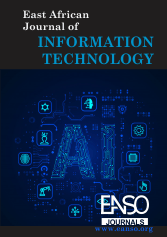Rule-Based Cyber Incident Detection and Response for Higher Education in Low-Resource Contexts: A Case Study of Universities in Eastern Uganda
Abstract
Higher education institutions (HEIs) in developing countries are increasingly dependent on digital systems for teaching, administration, and research. However, resource-constrained universities remain highly vulnerable to cyber threats such as phishing, ransomware, and web application attacks. To address these challenges, this study adopted the Design Science Methodology (DSM) to design, implement, and evaluate a lightweight, rule-based cyber incident analysis and response algorithm specifically tailored for universities in Eastern Uganda. The approach combined contextual data collection from six universities with simulation-based evaluations to ensure both practical relevance and technical validity. The algorithm, developed on a Laravel-PHP-MySQL stack, integrates rule-based detection, correlation of multi-stage attacks, and an administrative dashboard for IT staff. Simulation results showed strong performance with a recall of 92.8%, precision of 91.3%, and an F1-score of 92.1%. Response latency remained below 100 milliseconds, and the system maintained stability up to 450 requests per second. Benchmarking against Snort demonstrated higher precision and lower resource consumption, though Snort achieved slightly higher recall. This research contributes a context-appropriate and cost-effective cybersecurity framework for HEIs in low-resource contexts. It extends the Defense-in-Depth (DiD) and Resource-Based View (RBV) theories to constrained environments and provides practical recommendations for implementing modular, rule-based detection systems to enhance cybersecurity resilience in African universities
Downloads
References
Alom, M. Z., Bontupalli, V., & Taha, T. M. (2019). Intrusion detection using deep learning techniques: An overview. Journal of Big Data, 6(1), 101. https://doi.org/10.1186/s40537-019-0191-9
Bace, R. G., & Mell, P. (2001). Intrusion detection systems. National Institute of Standards and Technology. https://nvlpubs.nist.gov/nistpubs/Legacy/SP/nistspecialpublication800-31.pdf
Berman, D. S., Buczak, A. L., Chavis, J. S., & Corbett, C. L. (2019). A survey of deep learning methods for cyber security. Information, 10(4), 122. https://doi.org/10.3390/info10040122
Daily Monitor. (2021, December 14). Government agency hit by cyber-attack. Daily Monitor. https://www.monitor.co.ug/uganda/news/national/government-agency-hit-by-cyber-attack-3647928
Davis, J. (2020, June 29). UCSF pays $1.14M to NetWalker hackers after ransomware attack. TechTarget. https://www.techtarget.com/healthtechsecurity/news/366595656/UCSF-Pays-114M-to-NetWalker-Hackers-After-Ransomware-Attack
EDUCAUSE. (2023). 2023 cybersecurity in higher education report. EDUCAUSE. https://library.educause.edu
Hevner, A., March, S., Park, J., & Ram, S. (2004). Design science in information systems research. MIS Quarterly, 28(1), 75–105. https://doi.org/10.2307/25148625
Hutchins, E. M., Cloppert, M. J., & Amin, R. M. (2011). Intelligence-driven computer network defense informed by analysis of adversary campaigns and intrusion kill chains. Leading Issues in Information Warfare & Security Research, 1, 80–106.
Interpol. (2022). African cyberthreat assessment report. Interpol. https://www.interpol.int
Ivanova, G., & Jovanovic, I. (2019). Web application firewall ModSecurity as an intrusion detection system. International Journal of Computer Applications, 182(22), 29– 34. https://doi.org/10.5120/ijca2019918619
Kisangala, G., Ocen, G. G., & Odongtoo, G. (2025). Cybersecurity threats and preparedness in Ugandan universities: A contextual analysis [Unpublished survey dataset]. Busitema University.
Maheswaran, N., Bose, S., & Natarajan, B. (2024). An adaptive multistage intrusion detection and prevention system in a software defined networking environment. Automatika, 65(4), 1364– 1378. https://doi.org/10.1080/00051144.2024.2372749
Maloof, M. A., & Stephens, G. D. (2018). ELICIT: A system for detecting and responding to coordinated cyberattacks. Computers & Security, 74, 1–15. https://doi.org/10.1016/j.cose.2017.11.007
Mensah, A., Ray, G., & Henseler, J. (2018). Defense-in-depth framework for cybersecurity. Journal of Information Systems, 32(3), 85– 100. https://doi.org/10.2308/isys-52055
National Information Technology Authority–Uganda. (2023). Annual IT and cybersecurity report 2022/2023. Kampala: NITA-U.
New Vision. (2023, December 4). Uganda Christian University warns of phishing attacks on staff emails. New Vision. https://www.newvision.co.ug
Moses. (2022). The influence of cyber norms in fostering Uganda’s bilateral and multilateral relations for responsible state behavior in cyberspace. The Centre for Multilateral Affairs. https://thecfma.org/wp- content/uploads/2023/10/The-Influence-of-Cyber-Norms-in-Fostering-Ugandas-Bilateral-and-Multilateral-Relations-for-Responsible-State-Behavior-in-Cyberspace.pdf
PML Daily. (2024, September 20). Experts warn of Uganda’s cybersecurity vulnerability. PML Daily. https://www.pmldaily.com/business/2024/09/experts-warn-of-ugandas-cybersecurity-vulnerability.html
Roesch, M., & Green, C. (2015). Snort open-source intrusion detection system. SANS Institute Reading Room. https://www.sans.org
Selim, S., Hashem, M., & Nazmy, T. M. (2011). Hybrid multi-level intrusion detection system. International Journal of Computer Science and Information Security, 9(5), 2–9. http://sites.google.com/site/ijcsis/
Sommer, R., & Paxson, V. (2010). Outside the closed world: On using machine learning for network intrusion detection. IEEE Symposium on Security and Privacy, 305–316. https://doi.org/10.1109/SP.2010.25
Uganda Communications Commission. (2023). Annual cybersecurity report 2022/2023. Kampala: UCC. https://www.ucc.co.ug/cybersecurity-report-2023
Verkerken, M., et al. (2023). A novel multi-stage approach for hierarchical intrusion detection. IEEE Transactions on Network and Service Management, 20(3), 3915–3929. https://doi.org/10.1109/TNSM.2023.3259474
Wernerfelt, B. (1984). A resource-based view of the firm. Strategic Management Journal, 5(2), 171– 180. https://doi.org/10.1002/smj.4250050207
Zhou, P., Zhou, G., Wu, D., & Fei, M. (2021). Detecting multi-stage attacks using sequence-to-sequence models. Computers & Security, 105, 102203. https://doi.org/10.1016/j.cose.2021.102203
Copyright (c) 2025 Gerald Kisangala, Gilbert Gilibrays Ocen, Godfrey Odongtoo

This work is licensed under a Creative Commons Attribution 4.0 International License.




























